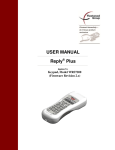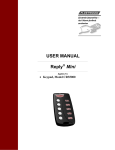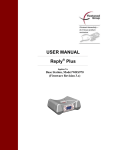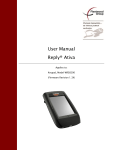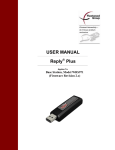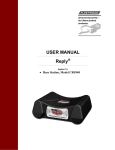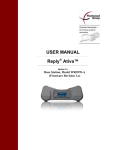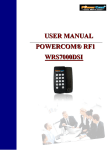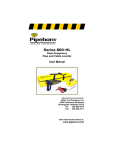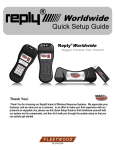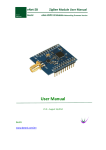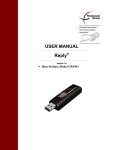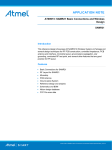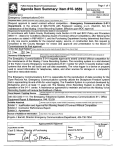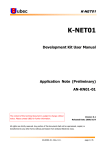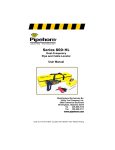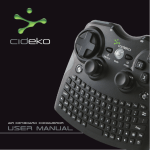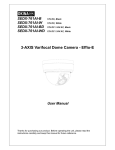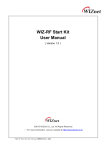Download USER MANUAL Reply Mini+
Transcript
USER MANUAL Reply® Mini+ Applies To: Keypad, Model WRS7000 (Firmware Revision 2.x) ©Copyright 2008 Fleetwood Group, Inc., Electronics Division. All rights reserved. Licensed software products are owned by Fleetwood Group, Inc. or its suppliers and are protected by United States copyright laws and international treaty provisions. Fleetwood Group, Inc. products are covered by U.S. and foreign patents, issued and pending. Information in this publication supersedes that in all previously published material. Specifications and pricing are subject to change without notice. Printed in the U.S.A. Fleetwood Group, Inc. Electronics Division 11832 James St. Holland, Michigan 49424 www.fleetwoodgroup.com www.replysystems.com Sales: 1-800-257-6390 Technical Service: 1-888-GO-REPLY (467-3759) Reply® is a registered trademark of Fleetwood Group, Inc. Other trademarks contained herein are the property of their respective holders. Revision History: ii Rev Date Description A 07/14/08 Revision 2.x Original Table of Contents 1.0 REPLY® SYSTEMS ............................................................................................................................................. 1 1.1 INTRODUCTION .................................................................................................................................................... 1 1.2 APPLICATIONS/ADVANTAGES .............................................................................................................................. 1 1.3 RF COMMUNICATION ........................................................................................................................................... 1 1.4 TECHNOLOGY LEADERSHIP, PATENT PROTECTION, AND CERTIFICATION ............................................................ 1 1.5 OTHER FLEETWOOD GROUP, INC. PRODUCTS ...................................................................................................... 1 2.0 PRINCIPLES OF OPERATION......................................................................................................................... 2 3.0 SYSTEM DESCRIPTION AND SETUP ............................................................................................................ 2 3.1 ROOM LAYOUT .................................................................................................................................................... 2 3.2 PLACEMENT OF THE REPLY® SYSTEM .................................................................................................................. 2 4.0 BUTTON DESCRIPTIONS................................................................................................................................. 3 4.1 LINK KEY............................................................................................................................................................. 3 4.2 SEND KEY ............................................................................................................................................................ 3 4.3 ALERT KEY .......................................................................................................................................................... 3 4.4 SYMBOL KEY ....................................................................................................................................................... 3 4.5 NUMBER KEYS ..................................................................................................................................................... 3 5.0 SYSTEM OPERATING MODES ....................................................................................................................... 3 6.0 STATIC MODE KEYPAD .................................................................................................................................. 3 7.0 DYNAMIC MODE KEYPAD.............................................................................................................................. 4 7.1 CONNECTING TO A BASE ...................................................................................................................................... 4 7.2 DISCONNECTING FROM A BASE ............................................................................................................................ 4 8.0 KEYPAD SETTINGS RETRIEVAL .................................................................................................................. 4 8.1 KEYPAD LOCALLY ............................................................................................................................................... 4 8.2 RETRIEVAL USING TRAINER ................................................................................................................................ 5 9.0 KEYPAD OPERATION....................................................................................................................................... 5 9.1 AVAILABLE ANSWER TYPES ................................................................................................................................ 5 9.1.1 Single-Digit Numeric ................................................................................................................................... 5 9.1.2 Multi-Digit Numeric..................................................................................................................................... 5 9.1.3 Other Question Types................................................................................................................................... 5 9.2 CHANGING ANSWER TYPES ................................................................................................................................. 5 9.3 LOW BATTERY WARNING .................................................................................................................................... 5 9.4 RF PERFORMANCE ............................................................................................................................................... 6 10.0 KEYPAD BATTERY REPLACEMENT ......................................................................................................... 7 11.0 WRS97X DATA FORMAT AND COMMAND LISTS................................................................................... 8 12.0 SOFTWARE........................................................................................................................................................ 8 13.0 ACCESSORIES .................................................................................................................................................. 8 14.0 LIMITED PRODUCT WARRANTY ............................................................................................................... 9 15.0 FCC, IC, AND EU COMPLIANCE INFORMATION.................................................................................. 10 iii 15.1 STANDARDS AND GUIDELINES..........................................................................................................................10 15.2 FCC/IC COMPLIANCE ......................................................................................................................................10 15.3 EU COMPLIANCE ..............................................................................................................................................10 16.0 TECHNICAL SPECIFICATIONS ..................................................................................................................11 17.0 TROUBLESHOOTING PROCEDURES .......................................................................................................12 18.0 INDEX ................................................................................................................................................................13 iv ® 1.0 Reply Systems 1.1 Introduction This product consists of wireless (RF) handheld 14key numeric keypads and a Base Station. The system is generally used to record answers to multiple choice questions as part of a classroom presentation, decision-making session, focus group, or videoconference. It offers methods for collecting and immediately reporting group response. Reply® systems have been available for several years and over 400,000 keypads are currently used worldwide. ® Reply is a wireless handheld response system that provides numeric data interaction for meeting or learning environments. Keypad responses are transmitted to the Base Station, which processes and delivers the information to the attached computer. Application software operates the Base Station and controls its associated Keypads. While the system’s hardware may offer powerful features, application software is the essential ingredient in applying the technology to generate useful results. 1.2 Applications/Advantages Many meeting and learning venues require a mechanism for audience interaction. Moreover, many seek a method of automating surveys and grading activities. Reply® meets the need for such an interactive tool, bringing everyone together and instantly allowing measurement of interest, understanding, and involvement. ¾ Audience members can participate from their seat and personally indicate their opinions, ideas, and knowledge. ¾ Results of the interaction are immediately available, and their display offers presenters a valuable insight into the opinion and comprehension level of audience members. ¾ System setup typically involves handing a Keypad to every participant and connecting the Base Station to a computer. No Keypad wires or cabling need be installed prior to use. This allows fast, reliable, safe, and attractive installation. 1.3 RF Communication The Keypads communicate with the Base Station using wireless Radio Frequency (RF) technologies. The patented proprietary design has been rigorously tested and optimized for reliability and collection speed. 1.4 Technology Leadership, Patent Protection, and Certification Fleetwood Group, Inc. maintains a leadership position in wireless development of audience response solutions. United States Patents 5,093,786, Re. 35,449 and other patents reflect the commitment to wireless technology leadership and the unique position that Fleetwood Group, Inc. brings to the market. Additional United States and foreign patents are pending. Fleetwood Group, Inc. also maintains a commitment to complying with the United States Federal Communications Commission and various foreign regulatory requirements. Others are continuously being added. Please contact your reseller or Fleetwood Group, Inc. for more information on certification. 1.5 Other Fleetwood Group, Inc. Products Fleetwood Group, Inc. is a manufacturer of quality electronic products that are sold through a worldwide reseller network. All Reply® products are designed and manufactured in Holland, Michigan. For more information on these products or our customization capability, please visit our website at www.replysystems.com. 1 2.0 Principles of Operation This Reply® System uses the latest in 2.4 GHz wireless technology to turn any meeting into a dynamic interactive experience for each participant without having to deal with a nightmare of cables and connectors. Fleetwood is unique in the marketplace with its patented technology to provide a two-way link with the keypads. This design ensures that no responses are missed by requiring a keypad to retransmit the user’s response until it is properly received by the Base Station. The design also allows the system to refuse to acknowledge any invalid entries. This is clearly superior to other technologies using one-way radio or infrared, which do not provide acknowledgment to the keypad when its entry is received and do not have any way of rejecting invalid entries. A radio frequency packet is continuously sent out by the Base Station when the unit is powered on. Each Base Station’s packet can only be received by keypads that have been set to the same Base ID. 3.0 System Description and Setup 3.1 Room Layout Base Station Computer Projector Figure 2. Typical Room Layout 3.2 Placement of the Reply® System Figure 1. System Diagram The WRS970 or WRS971 Base Station is the control center for the system and operates according to commands issued by the application software. The Base Station can be set to any of the 31 available Base IDs through the OCX module. Each Base Station can process responses from up to 500 keypads. 2 The Base Station can be located anywhere in the area where the keypads are to be used. WRS7000 keypads can operate in a room up to 300’ x 300’ (100m x 100m) in size. The total range of the system is determined by the base and keypad, whichever is shorter. Despite a robust communication system, walls and some other 2.4 GHz devices can moderately to severely limit the system’s performance. If coverage of a larger area is necessary, elevation of the Base Station or centering in room can usually improve the reception of the keypad signals. NOTE: Due to the properties of signals operating at 2.4 GHz, Fleetwood does not recommend placing any walls between the base station and the keypads. The material in a wall tends to absorb the RF signal and some reduced performance might be observed. 4.0 Button Descriptions This key can be allowed or locked out in any of the available question types. 4.4 Symbol Key The asterisk key is available for both multi-digit and single-digit voting sessions. It only produces an asterisk, unlike the symbol key on the WRS7200. The asterisk key can be disabled through software in single digit question types. 4.5 Number Keys Figure 3. WRS7000 Keypad 4.1 Link Key The Link key is used when connecting to a system while the keypad in configured for operation in Dynamic mode. See Section 7.1 for the procedure. The Link key can also be used to cancel actions. In Static or Dynamic mode operation, the Link key can cancel a vote rather than wait for the timeout period. In Dynamic mode, it can cancel the connect process at any time. 4.2 Send Key The Send key is used to complete multi-digit entries. Single-digit voting does not use the send key. The Send key is also used to begin connecting to a base. See Section 7.1. 4.3 Alert Key The number keys are used for voting and entering a Base ID. Any of the number keys can be disabled via the software to further limit invalid key presses in single-digit operation. 5.0 System Operating Modes The system has two operating modes available: Static mode and Dynamic mode. For security purposes, both the base and the keypads must be configured to the same mode, as they are not interoperable. This means that a Dynamic system does not operate with a Static system. Keypads must be configured locally using a Reply Trainer (WRS960X-T) and Base Stations are configured through the software. For changing the operating mode of the keypad, see the WRS960X-T User Manual. 6.0 Static Mode Keypad The Alert key sends a special packet to the Base Station to alert the presenter. It cancels a partially entered vote if a multi-digit answer has been started. A keypad in Static mode is configured to a specific Base ID and address. Both of the settings are configured using Reply Trainer. Each keypad on a system must be set to the same Base ID of the Base Station to be used. The address of each keypad in a system must be a unique number between 1 and 500. 3 To obtain best system performance, start at address 1 and continue up to the number of keypads to be used. Once the system is configured, the settings are maintained indefinitely. The keypad can only be used on the Base ID it is programmed or trained to. If more flexibility is desired (moving a keypad from base to base or room to room, for example) use Dynamic mode operation described in the next section. 7.0 Dynamic Mode Keypad A keypad in Dynamic mode can easily be used with various Base Stations by keying in the two-digit Base ID for the system with which to connect. The keypad can begin a session in one room and then later be changed to another without the need for a Reply Trainer. When configured to Dynamic mode, only the Link button may be used until the keypad is assigned a Base ID and is connected to a Base Station. The keypad remembers the Base ID for a period of two hours after the last successful vote. 7.1 Connecting to a Base Press the Link key. The LED lights red. Next press the two-digit Base ID of the system to connect to (i.e. ‘05’ to connect to Base ID 5). The LED lights bright green and then dim after each digit. Only the last two digits entered are kept, so if a mistake is made, key in the two desired digits. Press the Send key to begin negotiating with the base. The LED lights bright orange, and dims while communicating with a base. If the LED remains a solid orange, the keypad is not communicating with a base. Either the wrong Base ID was entered, or the base may not be set to the Dynamic operating mode. Once the keypad successfully connects with the system, the LED lights green momentarily. The keypad is then ready for voting on the system. If the LED lights red, the negotiation was unsuccessful. Try the Base ID again or see the system administrator for help. Note: If the keypad is connected to a previous system and the attempt to connect to the new system fails (or not found) the keypad will maintain the previous system connection until an event described in the next section occurs. 4 7.2 Disconnecting from a Base There are five ways to disconnect a keypad from a system. 1. Timeout – After a period of two hours without an acknowledged vote, the keypad will disconnect from the Base Station and power down. 2. Connect to Base ID 00 – Press the Link key, followed by ‘00’ and Send to disconnect from the Base Station and power down. 3. Connect to another base other than the current one. The keypad does not have to be disconnected from the previous base to connect to the next one. If the connection to the new base is successful, it loses it previous connection. 4. Software power down command – A command can be sent from a Reply Plus Base Station to power down all connected keypads. NOTE: A final key press is required by the keypad to receive the power down system status. The vote is not sent to the base. 5. Swiped using Reply Trainer – Swiping the keypad with Trainer to either change operating mode to Static or query the configuration using the Read Keypad Settings functionality. 8.0 Keypad Settings Retrieval 8.1 Keypad Locally To verify keypad settings, hold the 1 and Link key simultaneously for 3 seconds. The LED will begin flashing to indicate the Base ID and address. Green flashes represent numbers, and red flashes are used to separate the green flashes. The format is as follows: Tens Digit of Base ID Red Flash Ones Digit of Base ID Red Flash small pause Hundreds digit of keypad Address Red flash Tens digit of keypad Address Red flash Ones digit of keypad Address Red flash If the Base ID is below 10, the sequence starts with a red flash. For any 0 digits, there are no green flashes. The above description works whether the keypad is configured to Static or Dynamic operating modes. If it is in Dynamic mode and the keypad is not connected to a Base Station, the report responds with all red blinks since the keypad has no unique address yet. 8.2 Retrieval Using Trainer Keypad settings can be retrieved using the Reply Trainer’s reporting functionality. It reports which mode the keypad is configured to: Static or Dynamic. The Trainer cannot tell which Base ID and address a Dynamic keypad has received once connected to a base. When the dynamic is placed on the Trainer, the keypad will disconnect from the base. That information can be gathered either from the software using the keypad serial number or using the method described in Section 8.1. See the Trainer User manual for more information. 9.0 Keypad Operation 9.1 Available Answer Types All answer types are determined by the PC software. The software must be connected to the base for data to be sent from the keypad. An attempt to send data before then may either blink the green LED to alert the keypad is being polled or the keypad’s green LED will remain lit if no base is polling. In either case, when the keypad timeout expires, the red LED lights. The keypad supports the answer types described below: 9.1.1 Single-Digit Numeric This answer type uses the keys marked 0 – 9 on the keypad. The asterisk and the ALERT keys are functional. When the vote is entered, it transmits immediately and the SEND key is not used. The LED lights green when a key is pressed. It turns off once the vote has successfully been sent or it will light red if the vote could not be sent. If the key is locked out by the software, the light changes from green to red and remains red until a valid key is entered or the keypad times out after 9 seconds. Another key can be entered at any time to change a vote value. Most software packages accept the last key pressed as the final vote. 9.1.2 Multi-Digit Numeric The keypad allows up to 12 digits for an answer. The green LED lights to full brightness briefly and then dims. The dim light means the keypad is waiting for another digit. Either enter another digit or press the Send key to complete the vote. Each valid key press extends the 9 second timeout period for entering more data. The vote is successful when the green light goes out after pressing the send key. If it changes to red and then turns off, the vote did not complete (either before or after the send key is pressed). Most software packages only save the last received vote so if a mistake was made, either wait the timeout period or press Send and enter the vote again. The asterisk key can be used in this mode if allowed through software. If the asterisk key is filtered the keypad LED lights red. The timeout period expires and the vote is not sent. 9.1.3 Other Question Types The keypad does not support the other questions types that are available in the Reply Plus system. When a system is configured to these modes, the keys will light and remain red (similar to locking out a key). The alert key is the only key that can function but it can also be locked out through software control. 9.2 Changing Answer Types Since only the software determines what the answer type is going to be, no configuration of the keypad is necessary. There is a scenario where the keypad may be in the process of sending vote data when a new question gets asked. The previous data transmission may be cancelled. The keypad will light the red LED to alert that the transmission may not have completed successfully. This can also happen if a multi-digit answer is partially entered on the keypad and another question is asked. The keypad will light the red LED and the previously entered data is cleared. 9.3 Low Battery Warning The keypad contains a feature to alert when the battery is low and should be replaced. After a vote, the keypad will blink the red LED four times before turning off. This occurs on each vote until the battery is replaced. The battery should be replaced at earliest convenience to ensure operation continues. The keypad battery level is also sent to the software on each vote regardless of the level. This can be useful to find full, partial and low batteries if the software contains this feature. The Reply Trainer is also capable of retrieving and reporting the battery level of keypads. See the Trainer User Manual for more information. 5 9.4 RF Performance There are three commonly used channels for wireless internet access points: Channel 1, 6 and 11. The base station can be set up to avoid 1 to 2 of these channels if needed. The available settings are displayed in Table 1. See your network administrator for help in determining the optimum setting. The WRS97x system is frequency hopping to avoid interferences from other products. However, a heavily used wireless internet access point can make certain frequencies more difficult to transmit on. The keypad blinks the green LED when sending the vote data if it has trouble transmitting to the base. This may be caused by other interference or a keypad that is near the range limit of keypad to base. For areas that don’t have wireless internet issues but are using multiple Reply systems in nearby rooms, it is recommended to lower the power level setting to avoid system interference. Set the power to what is necessary to reliably cover the room or area in which the system is operating. The power level options are displayed in Table 2 for the WRS7200 keypad. Table 1. Wifi Channel Avoidance Settings Avoid Wi-Fi Setting Low Channels can be avoided Avoid 2425 to 2475MHz (avoid Wi-Fi channels 6 and 11) LowMid Table 2. Power Level Settings Avoid 2450 to 2475MHz (avoid Wi-Fi channel 11) LowHigh Power Level Avoid 2425 to 2450MHz (avoid Wi-Fi channel 6) Mid Avoid 2401 to 2425 and 2450 to 2475MHz (avoid Wi-Fi channels 1 and 11) MidHigh Low 0.01 mW Mid 0.1 mW High 0.3 mW Europe Max Avoid 2401 to 2425MHz (avoid Wi-Fi channel 1) High Power (mW) 1 mW (default for all systems) Avoid 2401 to 2450MHz (avoid Wi-Fi channels 1 and 6) Figure 4. Wi-Fi Frequency Avoidance Reply® Plus Wi-Fi Avoidance Settings Channel 1 Channel 6 Channel 11 Avoid Low/Mid Channel Avoid Low/High Channel Avoid Mid/High Channel Avoid Mid Channel Avoid Mid Channel Avoid Low Channel Avoid High Channel No WiFi Avoidance 2401 2410 2420 2430 2440 2450 2460 2470 2.4 GHz Band (MHz) KEY - Typical Wi-Fi Channels 6 - Reply® Plus Frequency Usage 10.0 Keypad Battery Replacement Each keypad is powered from a single CR2032 Lithium Coin cell battery. One fresh CR2032 battery can last for up to 20,000 votes in Static mode. INSTRUCTIONS 1. 2. 3. 4. 5. Remove screw from case back. Separate case parts at screw location. Using a non-metallic object, carefully push the battery out of the retainer from the back side. Pull the rest of the way out. Slide in new battery with positive side away from circuit board. 1 2 3 4 Figure 5. Keypad Battery Replacement 7/31/2007 TL 11.0 WRS97x Data Format and Command Lists The Base Station data format, command lists, and associated microcode are proprietary to Fleetwood. People who wish to develop their own applications may purchase the Reply® WRS970 API. This is a software developer’s toolkit that includes the necessary communication drivers for the base station. 12.0 Software Off-the-shelf software packages are available for Reply®. These packages are available through Fleetwood’s network of qualified dealer-developers. Most Reply® compliant software applications require the Windows operating system (trademark Microsoft Corporation). Contact Fleetwood for details on the software applications that are certified for use with Reply® products. 13.0 Accessories Call Fleetwood or an authorized dealer for information on available storage/shipping cases, extra cables or power supply kits for the Reply Plus system. 8 14.0 Limited Product Warranty Fleetwood Group, Inc. warrants its Reply® Cordless Response System components for a total period of 24 months from the date of manufacture for any material or workmanship defect in the product, and 90 days from date of shipment on all accessories. This warranty does not extend to batteries or any product component, which has been subjected to misuse, neglect, accidental breakage, improper installation, use outside of present guidelines, or alteration outside of our factory. Reply® Base Stations and Keypads use internal antennas built directly on the printed circuit board. Modifying the antennas in any way will result in reduced range and will void the warranty. There are no user serviceable parts inside Reply® Base Stations or Keypads. Fleetwood Group, Inc. agrees to remedy, at the factory, any product defect, or at its discretion, replace any component or part of the product provided the owner complies with the following procedures: The owner is to determine that the problem is not the battery or a faulty or improper connection with the personal computer or power source. The owner will contact our Product Service Coordinator during standard hours Monday through Thursday 7:00 AM to 3:30 PM and Friday 6:00 AM to 12:00 PM Eastern Standard Time at 1-888-GO REPLY (467-3759) or www.replysystems.com/rma/ to obtain a Return Material Authorization (RMA) number prior to shipping the product back to the factory. The owner will send the defective component via prepaid freight to: Fleetwood Group, Inc. Electronics Division Product Service Coordinator RMA#: 11832 James Street Holland, MI 49424 If the factory determines the defect is due to negligence or oversight on the part of the owner, the owner will be invoiced for the cost of the repair. 7/31/2007 TL 15.0 FCC, IC, and EU Compliance Information WRS7000 contains N240D RF Module Responsible Party Pertaining to the Declaration of Conformity Fleetwood Group, Inc. 11832 James Street Holland, MI 49424 Attn: Product Service Coordinator Phone: 888-467-3759 15.1 Standards and Guidelines This device complies with the following European Directives and USA/Canada Regulations: ¾ Directive 1999/5/EC on radio equipment and telecommunication terminal equipment and the mutual recognition of their conformity ¾ Directive 2006/95/EC on the harmonization of laws of member states related to electrical equipment designed for use within certain voltage limits ¾ The USA Federal Communications Commission (FCC) Rules and Regulations ¾ Industry Canada Rules and Regulations This device complies with the following national and international standards: ¾ EN 301 489-1 V1.6.1: 2005: EMR; EMC standard for radio equipment and services. Part 1: Common technical requirements. ¾ EN 301 489-17 V1.2.1: 2002: EMR; EMC standard for radio equipment and services. Part 17: Specific conditions for 2.4 GHz wideband transmission systems and 5 GHz high performance RLAN equipment. ¾ EN 300 328 V1.7.1: Electromagnetic compatibility and Radio spectrum Matters (ERM);Wideband transmission systems; Data transmission equipment operating in the 2,4 GHz ISM band and using wide band modulation techniques. ¾ EN 60950-1: 2001 + A11: 2004: Information technology equipment – Safety. Part 1: General requirements ¾ FCC Part 15B, 15.247: 10-01-2006: Radio Frequency devices: Operation within the bands 902-928 MHz, 2400-2483.5 MHz, and 5725-5850 MHz. ¾ IC RSS-210 Issue 7: 2007: Low power license-except radio-communications devices (all frequency bands): Category 1 equipment. 15.2 FCC/IC Compliance This device complies with Part 15 of the FCC Rules and RSS-210 of the Industry Canada Rules. Operation is subject to the following two conditions: (1) this device may not cause interference and (2) this device must accept any interference, including interference that may cause undesired operation of the device. The user is cautioned that changes or modifications to the device that are not approved by the manufacturer could void the user’s authority to operate the device. 15.3 EU Compliance This device is a 2.4 GHz low power response system controller intended for residential and commercial use in all EU and EFTA member states. 10 Notice The base and keypad units may be susceptible to Electrostatic Discharge (ESD) and other similar fast transient events causing system interruption. Should system interruption occur, reboot computer, reset base unit by disconnecting and reconnecting USB cable and push any key on keypads which have powered down. 16.0 Technical Specifications Enclosure Symbol Parameter dl Value Unit Min Typ Max Length - 3.1 - in. dw Width - 1.55 - in. dh Height (Thickness) - 0.47 - in. wb Weight With Battery Without Battery 0.05 0.045 - lbs Min Typ Max 2.1 - 3.6 Power Value Symbol Parameter VDD Voltage Vlvw Low Voltage Warning 2.1 V Vlvs Low Voltage Shutdown 1.9 V T Operating Temperature * 55(15) 100(40) Unit V F(C) * The keypad will operate from 0 to 50 C when using a new battery, however optimal battery life is only possible over the specified temperature range. 7/31/2007 TL 17.0 Troubleshooting Procedures ISSUE POSSIBLE CAUSE SOLUTION Keypad does not turn on Battery may be inserted backwards. Check that the positive side of the battery is touching the coin cell retainer. Battery is dead. Replace the battery. Base not in open area. Do not place the base inside cabinets. Base located too close to other electronic equipment Place the base away from other electronic devices, such as TV’s, DVD/VCR players and similar. More than one base unit on the same Base ID Check that the bases covering an area are not on the same Base ID. Other Interference Always physically separate other radio devices by at least 10’ (3 m). This includes WiFi, Bluetooth, ZigBee and other similar devices. Multiple Base Stations are too close Keep base stations separated and do not stack units. Keypad battery dead. Replace the coin cell battery. Keypad operating too far from base station. Move closer to the base station to see if voting improves. Power level setting too low. Check that the power level setting of the system is appropriate for the range trying to be achieved (Some countries have restrictions as to the power level setting allowed. See Section 15.0). Interference See “Poor RF Performance”. Keypad Base ID setting and base setting are not matched. Change either the base or keypads so they match. Poor RF Performance Short range with keypads Keypad vote not sending 12 18.0 Index A Accessories, 8 Address Settings, 4 Answer Types, 5 P Patent information, 1 R B Base Connecting to, 4 Disconnecting from, 4 Reply Trainer. See 'Operting Modes' Return Parts, 8 RF communication, 1 RF Performance, 6 S Batteries, 7 F Service, ii, 9 Software, 8 Fleetwood products, 1 I Interface, 8 T Technical Specifications, 11 Trainer. See ‘Operating Modes’ Troubleshooting, 12 O Operating Modes, 3 Dynamic, 4 Static, 3 V Voting, 5 W Warranty, 9 7/31/2007 TL

















